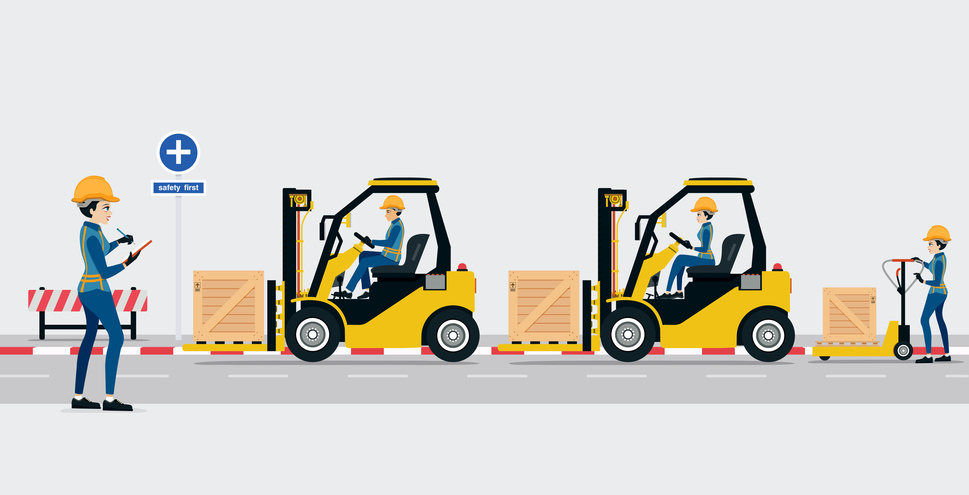Customers usually rely heavily on the logistical processes of enterprises for ensuring proper storage and distribution of concerned products. Be it an authorized distribution center or a proper warehouse, safety happens to be the primary concern when it comes to controlling hazards and ensuring the well-being of workers. Warehouse safety, therefore, is one logistical balancing activity which is often overlooked in the wake of industrial growth.
Although safeguarding a warehouse comes with myriad set of benefits, there are times when inadequate resources, insufficient time and lack of opportunities come out as the main reasons why the same gets compromised in the long run. However, results are readily visible when the safety measures are implemented— assisting enterprises with higher productivity and improved employee satisfaction.
Why Warehouse Safety is an Important Logistical Cog?
Disregarding warehouse safety readily kills off the reliability quotient. Companies, often lose out on a loyal customer base if the condition of products— stored and distributed via warehouses— isn’t top-notch. Moreover, strengthening the safety regulations readily minimizes the risk of injuries and workplace disruptions caused due to uncalled mishaps.
Apart from that, warehouse safety also lowers down the equipment downtime— associated with any industrial setup.
How to Go about Warehouse Safety— Enlisting the Safety Guidelines
In the subsequent sections, we shall be talking about the existing safety guidelines— associated with a warehouse or any distribution center. These measures should be diligently followed by workers and employees— for minimizing injuries, product damage and everything that negatively impacts the growth of the logistical interface of an organization.
- Using Safety Equipment
When it comes to managing a warehouse, special emphasis must be given to the heavier items in play. It is therefore advisable to work with hydraulic dollies and even forklifts for lifting the same. In addition to that, warehouse staff should use proper eyewear at work. Hard hats should be made mandatory in a similar working environment.
Educating employees about fire exits and installed sprinklers— in case of fire-based emergencies— is advisable. Adding to the list of equipment is therefore important when it comes to strengthening the warehouse safety guidelines. While these attributes take out the obvious issues of injuries, they also instill faith concerning the workplace environment. Enterprises flinching about the increased costs must understand that having warehouse safety covered readily pays off in the long run.
- Eliminate Safety Hazards
Potential hazards are common to a warehouse working environment. However, it is important to eliminate most of them via regular safety checks. Elementary precautions include keeping the floor free of liquids, stray cords and items that spill off. Covering pits and floor cracks in also an important aspect towards handling potential threats.
- Label Hazardous Zones
Warehouse safety guidelines seem incomplete without the hazardous zones getting a mention. When it comes to a warehouse environment, it is important to label zones for safe walk and other non-professional activities. However, it isn’t advisable to arbitrarily assigned zones as proper signage and authorization are needed.
Black paint, tape and even white stripes can help if the enterprises are vigilant about the safety of workers and concerned employees. Having hazardous areas marked can easily avoid accidents.
- Incorporate Safer Techniques while Lifting
Most warehouse inclusions are heavy and need to be transported with care. Therefore, it is important to assess the best options available for lifting goods. Firstly, warehouse superintendents need to ensure the best possible route for the product in picture. Once an obstacle-free pathway is identified, safe lifting strategies must come into the picture.
Some of the best tactics include using push methods instead of pull. Moreover, it is also advisable to lean in the exact direction of the load— while moving the object. Enterprises using forklifts must train drivers and only authorize experienced personnel for lifting.
- Provide Refresher Course and Training
Warehouse staff should be updated about the workplace environment and even safe practices at work. Education and training are the important aspects to better adherence and staff members need to be fully aware of the risks involved. Cutting corners— in terms of staff training— often lead to catastrophic consequences. That said, warehouse management must be aware of the repercussions and this is why courses and training should be given precedence.
- Promote Warehouse Awareness
Probably the most overlooked aspect of warehouse safety— overall awareness is a pertinent aspect which needs to be promoted— in every possible manner. One way of achieving the same includes healthy communication between the staff members. Moreover, the employees need to be vocal about their requirements and even discrepancies at work. One example would be a simple yet important “coming through” alert which lets coworkers know that something heavy or inflammable is crossing the pathway.
Every person— within the warehouse— needs to learn about the terms and terminologies used by the coworkers.
Warehouse safety is a critical aspect and even plays an important role in customer satisfaction and retention. While most of the mentioned tactics are easy to implement, it must be understood that all of them are interlinked and readily work towards the betterment of the workplace environment.

